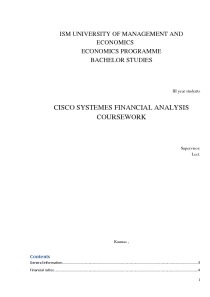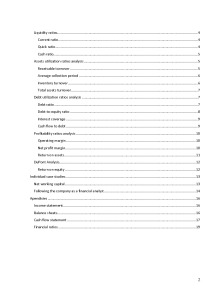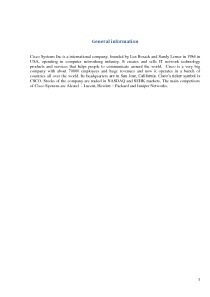Cisco Systemes Financial Analysis



General information. Financial ratios. Liquidity ratios. Current ratio. Quick ratio. Cash ratio. Assets utilization ratios analysis. Receivable turnover. Average collection period. Inventory turnover. Total assets turnover. Debt utilization ratios analysis. Debt ratio. Debt-to-equity ratio. Interest coverage. Cash flow to debt. Profitability ratios analysis. Operating margin. Net profit margin. Return on assets. DuPont Analysis. Return on equity. Individual case studies. Net working capital. Following the company as a financial analyst. Apendixies. Income statement. Balance sheets. Cash flow statement. Financial ratios.
Cisco Systems Inc is a international company, founded by Len Bosack and Sandy Lerner in 1984 in USA, operating in computer networking industry. It creates and sells IT network technology products and services that helps people to communicate around the world. Cisco is a very big company with about 70000 employees and huge revenues and now it operates in a bunch of countries all over the world. Its headquarters are in San Jose, California. Cisco’s ticker symbol is CSCO. Stocks of the company are traded in NASDAQ and SEHK markets. The main competitors of Cisco Systems are Alcatel - Lucent, Hewlett – Packard and Juniper Networks.
We can see current ratio was growing through the years 2007 2008 and 2009 , but in 2010 they were effected by second wave of crisis and ratio decreased from 3.24 to 2.67. All the ratios are above the 1, so that means the company would be capable to pay off its obligations. From that we can see that company‘s financial health is stable.
From 2007 to 2009 quick ratio was increasing ,but in 2010 it decreased from 3.16 to 2.6. Quick ratio is company’s liquidity indicator.
Cash ratio shows that from 2007 to 2009 company was still able to increase ability to cover its liabilities, but in 2010 it went down from ~2.56 to ~2.077.
The chart shows that total assets turnover was volatile every year, reason for that was total assets value changes. It means every year there was some movement of assets. In 2010 assets turnover recover to 0.5 and was the same as in 2008.
Total assets turnover shows that. Companies with high profit margins tend to have low asset turnover - it indicates pricing strategy.
Debt ratio was slightly going down each year form 2007 to 2010. That means Cisco was increasing number of assets in proportion with liabilities. Debt ratio of less than 1 indicates that a company has more assets than debt and It shows company’s level of risk. We can see that Cisco is a small risk taker.
- Economy & Finance Individual works
- Microsoft Word 201 KB
- 2020 m.
- English
- 19 pages (2349 words)
- University
- Dell

















